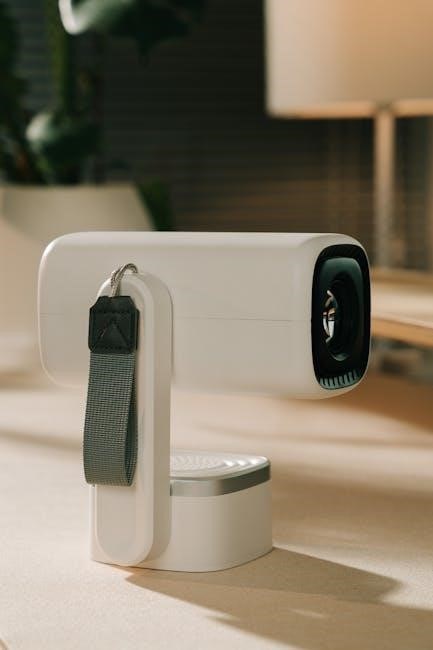Choosing the right air filter size is crucial for optimal HVAC performance‚ proper airflow‚ and maintaining indoor air quality. This guide helps you understand the importance of air filter dimensions and how to select the perfect fit for your system.
Why Air Filter Size Matters
Air filter size affects HVAC efficiency‚ air quality‚ and system longevity. The right size ensures proper airflow and filtration‚ preventing system strain and maintaining optimal performance.
System Efficiency and Performance
The correct air filter size ensures optimal HVAC system efficiency and performance. Properly sized filters allow adequate airflow‚ preventing system strain and maintaining energy efficiency. A filter that is too small or too large can disrupt airflow‚ leading to reduced heating and cooling performance. Ensuring a precise fit guarantees that your system operates as intended‚ maintaining consistent air pressure and overall efficiency. This directly impacts the system’s ability to heat‚ cool‚ and circulate air effectively.
Air Quality and Filtration Effectiveness
The right air filter size is essential for maintaining superior air quality and filtration effectiveness. A properly fitting filter ensures that all airborne contaminants‚ such as dust‚ pollen‚ and pet dander‚ pass through the filter media‚ preventing them from circulating in your space. Incorrect sizes can lead to gaps‚ reducing filtration efficiency and allowing pollutants to bypass the filter. This can compromise indoor air quality‚ potentially aggravating allergies and respiratory issues. Choosing the correct size ensures optimal filtration performance and cleaner air.
System Longevity and Maintenance
The correct air filter size plays a critical role in maintaining your HVAC system’s longevity and reducing maintenance needs. A properly sized filter ensures even airflow‚ preventing strain on the system‚ which can lead to premature wear and tear. An ill-fitting filter may cause increased energy consumption‚ higher repair costs‚ and more frequent replacements. By selecting the right size‚ you extend the system’s lifespan‚ reduce mechanical stress‚ and maintain optimal performance‚ ensuring your HVAC system runs efficiently for years to come.

Common Air Filter Sizes
Standard air filter sizes include 16x20x1‚ 20x20x1‚ 16x25x1‚ and 20x25x1 inches. These dimensions are widely used in residential and commercial systems‚ ensuring compatibility and ease of replacement.
Standard Air Filter Dimensions
Standard air filter dimensions are widely recognized and commonly used in residential and commercial HVAC systems. Typical sizes include 16x20x1‚ 20x20x1‚ 16x25x1‚ and 20x25x1 inches‚ referring to height‚ width‚ and depth. These dimensions ensure compatibility with most systems and are easily available for replacement. Standardization simplifies the process of finding the right filter‚ reducing guesswork and ensuring a proper fit. Using standard sizes also guarantees optimal performance‚ balancing filtration efficiency and airflow requirements for maintained indoor air quality and system efficiency.
Whole-House Air Filter Sizes
Whole-house air filters are designed to cover entire HVAC systems‚ ensuring consistent air quality throughout your home. Common sizes include 20x30x1‚ 25x25x1‚ and 20x25x1 inches‚ tailored for larger systems. Proper sizing is critical for even airflow and filtration efficiency. Measuring your system or consulting manufacturer specifications helps ensure the right fit. Incorrect sizes can lead to reduced performance or maintenance issues‚ making accurate measurement essential for optimal whole-house air filtration and system longevity.
Custom Air Filter Sizes
Custom air filter sizes are ideal for systems with non-standard dimensions or unique requirements. They ensure a perfect fit‚ maximizing efficiency and filtration. To determine custom sizes‚ measure the existing filter or duct opening‚ noting height‚ width‚ and depth. Some manufacturers offer bespoke options tailored to specific systems. Proper measurement is crucial to avoid gaps or restrictions‚ ensuring optimal airflow and performance. Custom filters are especially useful for older systems or specialized setups where standard sizes don’t fit.

How to Measure for the Right Air Filter
To find the correct air filter size‚ measure your existing filter or duct opening‚ noting height‚ width‚ and depth in inches. Use a tape measure for accuracy.
Checking Your Existing Air Filter
Start by inspecting your current air filter for printed size dimensions‚ usually located on the side or frame. These measurements provide the actual size in inches. If no labels are present‚ use a tape measure to record the height‚ width‚ and depth. Ensure accuracy‚ as incorrect sizing can lead to poor fit and reduced efficiency. If the filter appears too small or large‚ double-check by measuring the air duct opening to confirm the correct nominal size for optimal performance.
Measuring Your Air Duct
If your existing filter isn’t available or its size is unclear‚ measure the air duct opening where the filter is installed. Use a tape measure to record the height and width of the duct in inches. The depth is typically 1 inch for standard residential systems. Ensure the measurements are precise to determine the nominal size‚ which may differ slightly from the actual filter dimensions due to framing or other factors. This step guarantees the correct fit for optimal airflow and filtration efficiency.
Referencing Manufacturer Specifications
Consulting your HVAC system’s manufacturer specifications is the most reliable way to determine the correct air filter size. The user manual or product documentation typically lists the recommended filter dimensions and thickness. Ensure the filter matches these specifications to maintain system efficiency and warranty validity. If the manual is unavailable‚ visit the manufacturer’s website or contact their support team for guidance. This step ensures compatibility and optimal performance‚ avoiding issues like reduced airflow or system damage from incorrect sizing.

Types of Air Filters and Their Sizes
Air filters come in various types‚ including residential‚ commercial‚ and automotive‚ each with standard and custom sizes to fit specific systems and improve performance efficiently.
Residential Air Filters
Residential air filters are designed to improve indoor air quality and HVAC system efficiency. Common sizes include 16x20x1‚ 20x20x1‚ and 20x25x1 inches‚ fitting most home systems. These filters are typically 1-inch thick‚ offering standard filtration for dust and allergens. Proper sizing ensures optimal airflow and filtration efficiency‚ while incorrect sizes can lead to reduced performance. Always measure your existing filter or check system specifications to select the right size for your home.
Commercial Air Filters
Commercial air filters are designed for larger spaces and heavier-duty applications. They often come in larger dimensions‚ such as 24x24x2 or 36x48x4 inches‚ to accommodate industrial HVAC systems. These filters typically have higher MERV ratings for improved air quality in workplaces. Proper sizing is critical to ensure efficient airflow and filtration. Measure the existing filter or consult system specifications to select the right size. Incorrect sizes can compromise performance and air quality in commercial environments.
Automotive Air Filters
Automotive air filters are essential for engine performance and fuel efficiency. They come in various sizes‚ typically measured in inches‚ such as 12x12x1 or 15x15x2. Proper sizing ensures optimal airflow and filtration. Always check your vehicle’s manual or the existing filter for exact dimensions. Using the wrong size can lead to decreased performance or potential engine damage. Standard sizes vary by vehicle make and model‚ so precise measurement or consultation with the manufacturer is recommended to maintain your car’s efficiency and longevity.

Factors Affecting Air Filter Size
Factors affecting air filter size include nominal vs. actual dimensions‚ MERV ratings influencing thickness‚ and HVAC system specifications requiring precise measurements for optimal performance and fit.
Nominal vs. Actual Size
Nominal size refers to the standard dimensions listed by manufacturers‚ while actual size represents the exact measurements of the air filter. It’s crucial to measure your existing filter or duct to ensure accuracy‚ as nominal sizes may not always match the actual required dimensions. Using a tape measure‚ record the height‚ width‚ and depth in inches. Standard sizes like 16x20x1 or 20x25x1 are common‚ but precise measurements are essential to avoid improper fit and performance issues. Always verify before purchasing to ensure optimal system efficiency.
MERV Rating and Filter Thickness
The MERV (Minimum Efficiency Reporting Value) rating measures an air filter’s ability to capture particles. Higher MERV ratings indicate better filtration but may increase thickness‚ potentially restricting airflow. Standard filters typically range from MERV 8 to 13‚ with thickness varying from 1 to 5 inches. Always check your HVAC system’s specifications to ensure compatibility‚ as thicker filters may require modifications. Balancing MERV rating and thickness is key to maintaining efficiency and air quality without compromising system performance. Proper sizing ensures optimal airflow and filtration effectiveness.
HVAC System Specifications
Always consider your HVAC system’s specifications when selecting an air filter. Most systems require filters with specific dimensions‚ MERV ratings‚ and thickness to ensure proper airflow and efficiency. Check your system’s manual for recommended filter sizes and types. Using a filter that doesn’t match your HVAC’s specifications can lead to reduced performance‚ increased energy costs‚ or even system damage. Ensure compatibility by referencing manufacturer guidelines to maintain optimal operation and air quality. Proper sizing is essential for system longevity and effectiveness.
Choosing the Right Air Filter Size
Properly sizing your air filter ensures optimal system efficiency‚ airflow‚ and air quality. Measure your existing filter or duct‚ and consult manufacturer specifications to find the perfect fit.
Determining Face Velocity
Face velocity‚ the airflow rate through the filter‚ is crucial for system performance. Calculate it by dividing the airflow rate (CFM) by the filter’s surface area (sq. ft.). Proper face velocity ensures efficient filtration without restricting airflow. Too high or too low can lead to reduced efficiency or system damage. Measure your filter’s dimensions and consult manufacturer specifications to align face velocity with your HVAC system’s design requirements for optimal performance and longevity.
Accounting for Airflow Requirements
When selecting an air filter‚ it’s essential to consider your system’s airflow requirements. Proper sizing ensures the filter doesn’t restrict airflow‚ which can lead to reduced efficiency or increased energy costs. Measure your system’s airflow rate (CFM) and ensure the filter’s surface area aligns with these needs. Standard filter sizes often meet typical airflow demands‚ but custom solutions may be necessary for unique systems. Balancing airflow requirements with filtration efficiency ensures optimal performance and maintains indoor air quality effectively.

Installation Tips for Air Filters
Turn off power‚ remove the old filter‚ and install the new one ensuring a snug fit. Seal gaps and verify proper airflow for optimal performance.
Steps to Install a New Air Filter
Turn off the HVAC system power. 2) Locate the filter housing and open it. 3) Remove the old filter and dispose of it properly. 4) Check the new filter’s size matches the housing. 5) Install the new filter‚ ensuring the airflow arrows point correctly. 6) Close the housing securely. 7) Turn the system back on and verify proper airflow. This ensures efficient performance and maintains indoor air quality.
Common Mistakes to Avoid
- Forcing a filter that’s too large or small into the housing‚ which can lead to improper sealing and reduced efficiency.
- Neglecting to check the nominal vs. actual size‚ as stated on the filter‚ leading to poor fit and performance issues.
- Ignoring manufacturer specifications or existing filter dimensions‚ which can compromise airflow and system functionality.
Always measure carefully and refer to the system’s requirements to ensure optimal performance and air quality.

Maintenance and Replacement
Regularly check and replace air filters to maintain system efficiency and air quality. Replace filters every 3-6 months‚ depending on usage and manufacturer recommendations.
How Often to Change Your Air Filter
Replace your air filter every 3-6 months‚ depending on usage‚ allergies‚ and environmental factors. Homes with pets or high dust levels may require more frequent changes. Check filters monthly during peak usage seasons. A dirty filter can reduce system efficiency and air quality. Always follow manufacturer recommendations for replacement intervals to ensure optimal performance and longevity of your HVAC system.
Cleaning vs. Replacing Filters
Deciding between cleaning and replacing filters depends on the type and condition. Permanent filters can often be cleaned and reused‚ while disposable ones must be replaced. Check manufacturer guidelines for specific recommendations. Cleaning reusable filters can improve airflow and efficiency‚ but worn or damaged filters should be replaced to maintain optimal performance. Regular maintenance ensures better air quality and prevents system strain. Always prioritize replacement if cleaning no longer restores filter effectiveness.

Where to Buy Air Filters
Air filters are available at online retailers like Filterbuy.com‚ hardware stores such as Home Depot‚ or directly from manufacturers‚ ensuring convenience and compatibility for your needs.
Online Retailers
Online retailers like Filterbuy.com offer a wide selection of air filters in standard and custom sizes‚ making it easy to find the perfect fit for your HVAC system. Many websites feature filter finders and size charts to simplify your search. With competitive pricing‚ fast shipping‚ and detailed product descriptions‚ online stores provide a convenient shopping experience. They often cater to both residential and commercial needs‚ ensuring availability of various sizes and MERV ratings to meet specific filtration requirements.
Hardware Stores
Hardware stores like Home Depot‚ Lowe’s‚ and Ace Hardware offer a wide range of air filters in standard and common sizes. These stores provide easy access to replacement filters‚ with knowledgeable staff to assist in finding the right size. Many locations carry filters in various MERV ratings‚ ensuring you can find one that matches your system’s needs. Hardware stores are a convenient option for immediate purchase‚ allowing you to maintain your HVAC system’s efficiency and air quality without delays.
Manufacturer Direct
Purchasing air filters directly from manufacturers ensures compatibility with your specific HVAC system. Many manufacturers‚ such as Honeywell or Carrier‚ offer custom and standard sizes tailored to their units. Buying directly often provides access to genuine products‚ warranties‚ and customer support. While this option may be more expensive than retail stores‚ it guarantees a precise fit and optimal performance. This is particularly beneficial for systems requiring unique or custom air filter dimensions.

Troubleshooting Common Issues
Troubleshooting common issues involves addressing poor fits and reduced airflow due to incorrect filter sizes. Measure your duct or check existing filters to resolve these problems effectively.
Incorrect Size Leading to Poor Fit
Incorrect air filter size often leads to poor fit‚ compromising system efficiency and air quality. A filter that is too small may leave gaps‚ allowing unfiltered air to bypass it‚ while an oversized filter might be compressed‚ reducing airflow. Both scenarios can lead to reduced filtration effectiveness and increased energy consumption. Ensure accurate measurements by checking your duct or existing filter dimensions to avoid these issues. Proper fit is essential for optimal performance and maintaining indoor air quality.
Reduced Airflow Due to Wrong Size
Airflow reduction is a common issue when the wrong filter size is installed. An undersized filter may create gaps‚ allowing unfiltered air to bypass the system‚ while an oversized filter might be compressed‚ restricting airflow. Both scenarios lead to inefficient system performance and potential increases in energy consumption. Proper sizing ensures optimal airflow‚ maintaining system efficiency and indoor air quality. Always measure carefully or refer to manufacturer specifications to avoid airflow-related problems.

Advanced Considerations
- Understanding MERV ratings and their impact on filtration efficiency.
- Customizing filter sizes for unique HVAC systems and environments.
- Considering environmental factors like humidity and dust levels.
- Evaluating system-specific requirements for optimal performance.
Understanding MERV Ratings
MERV (Minimum Efficiency Reporting Value) ratings measure an air filter’s ability to capture particles. Ranging from 1 to 20‚ higher MERV ratings indicate better filtration. However‚ higher ratings can restrict airflow if the filter size or system isn’t compatible. Choosing the right MERV balance is crucial for maintaining air quality without compromising system performance. This guide helps you align MERV ratings with your HVAC system’s capabilities and air quality needs for optimal results.
Customizing Filter Size for Unique Systems
For systems with non-standard dimensions‚ custom air filters are essential. Measure your existing filter or ductwork to determine exact dimensions. Consider nominal vs. actual size differences and consult manufacturer specifications. Incorrect sizing can lead to reduced efficiency or poor fit. Use online tools or professionals to design filters that match your system’s unique needs. Custom solutions ensure optimal performance‚ airflow‚ and filtration‚ tailored to your specific HVAC setup. This approach guarantees a perfect fit and maximizes system efficiency.
Environmental Factors and Filter Size
Environmental factors significantly influence air filter size and performance. High pollution levels‚ humidity‚ and seasonal changes can affect filter efficiency. In polluted areas‚ larger filters with higher MERV ratings may be necessary to capture more contaminants. Moisture in humid climates can degrade filters‚ requiring specialized materials. Seasonal allergens like pollen might demand filters with increased capacity. Custom solutions may be needed for extreme conditions‚ ensuring optimal airflow and filtration. Environmental considerations are crucial for maintaining air quality and system efficiency‚ tailoring filters to specific regional and climatic needs.
Selecting the right air filter size is essential for maintaining HVAC efficiency‚ improving air quality‚ and extending system longevity. By understanding filter dimensions‚ measuring accurately‚ and considering environmental factors‚ you can ensure optimal performance. Regular maintenance and proper installation are key to maximizing benefits. Use this guide to make informed decisions‚ ensuring your system runs smoothly and effectively while providing clean‚ comfortable air for years to come.

